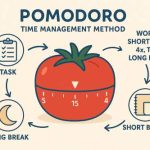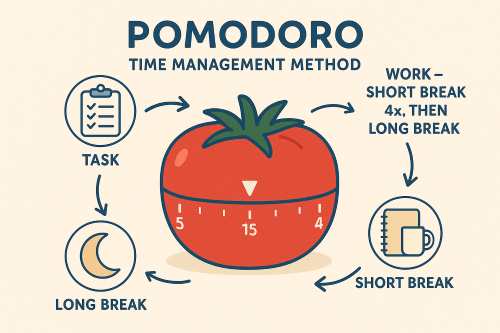Master the art of focused productivity with this comprehensive guide to the Pomodoro Technique, specifically adapted for modern digital distractions and remote work challenges.
The Modern Focus Crisis: Why Your Attention Span Matters More Than Ever
Here’s a mind-blowing stat that’ll make you rethink everything: the average person’s attention span has dropped from 12 seconds in 2000 to just 8 seconds today. Yeah, we now have shorter attention spans than goldfish. Pretty terrifying, right?
And it’s not just you feeling scattered. Between constant notifications, Slack pings, TikTok rabbit holes, AI tools demanding our attention, and the blur of hybrid work schedules, our brains are basically under siege 24/7. No wonder so many of us feel like we’re drowning in tasks but never actually getting anything meaningful done.
But here’s the thing – while our world has gotten infinitely more distracting, there’s this old-school technique that’s actually becoming more powerful than ever. I’m talking about the Pomodoro Technique, and before you roll your eyes thinking “another productivity hack,” hear me out.
Why the Pomodoro Technique Works in 2025
The Pomodoro isn’t just some trendy time management method. It’s a scientifically-backed approach that’s been helping people focus for decades. And in 2025? It’s basically your secret weapon against the attention economy that’s trying to hijack your brain.
Whether you’re a:
- Remote worker struggling with home distractions
- Student trying to focus in a world of infinite scroll
- Entrepreneur juggling seventeen different priorities
This guide is going to show you how to use Pomodoro technique in ways that actually work for modern life.
By the end of this, you’ll have a personalized focus system that fits your brain, your schedule, and your real-world challenges. No more generic “just focus for 25 minutes” advice that ignores how we actually live and work today.
What is the Pomodoro Technique? (The Basics Refresher)
Alright folks, let’s start with the basics because I know some of you are thinking “Pomo-what now?” The Pomodoro Technique was created by Francesco Cirillo back in the 1980s when he was a struggling university student. The guy was having trouble focusing (sound familiar?), so he grabbed a tomato-shaped kitchen timer – “pomodoro” means tomato in Italian – and committed to studying for just 10 minutes.
That simple experiment turned into a productivity method that millions of people swear by.
The Classic Pomodoro Method
The classic version works like this:
- Choose a task you want to work on
- Set a timer for 25 minutes
- Work on that task until the timer rings
- Take a 5-minute break
- Repeat the cycle
- After 4 cycles, take a longer break (15-30 minutes)
Why Does the Pomodoro Technique Work?
Well, your brain loves having clear boundaries. When you know you only have to focus for 25 minutes, it’s way easier to resist that urge to check Instagram or reorganize your desk drawer for the third time today. Plus, those regular breaks prevent mental fatigue and actually help you maintain focus longer.
But here’s where most people get it wrong – they think Pomodoro is just about setting a timer and white-knuckling through tasks. That’s like saying driving is just about stepping on the gas pedal. There’s so much more to it, especially in our hyper-connected world.
The magic isn’t in the 25 minutes. It’s in creating a rhythm that works with your brain instead of against it. And that’s where the 2025 version gets interesting.
The 2025 Pomodoro Evolution: What’s Changed
OK, let’s be real for a second. Francesco Cirillo created this technique in a world without smartphones, social media, Zoom fatigue, or AI chatbots. The biggest distraction back then was maybe a roommate playing music too loud or a landline phone ringing.
Modern Attention Challenges
Today? We’re dealing with a completely different beast:
- Your phone buzzes every 6 minutes on average
- Slack notifications and email alerts
- YouTube recommendations powered by AI that knows exactly what will grab your attention
- Work culture that expects instant responses to everything
The Remote Work Revolution
Plus, the way we work has totally transformed:
- Remote work means your office is also your kitchen, your bedroom, and your Netflix binge spot
- Hybrid schedules mean you’re constantly switching between home focus mode and office collaboration mode
- AI tools have added another layer of “productivity” pressure
Why This Makes Pomodoro More Powerful
But here’s the plot twist – all these changes actually make Pomodoro more powerful, not less. See, the technique was always about creating boundaries and protecting your attention. In 2025, that’s not just helpful – it’s absolutely essential for survival in the attention economy.
The Science Behind Modern Focus
The research on this is fascinating:
- Studies show that it takes an average of 23 minutes to fully refocus after an interruption
- That means if you’re getting distracted every few minutes, you’re literally never reaching peak focus
- The Pomodoro creates a protective bubble around your attention
And here’s something cool that’s emerged from recent neuroscience research: your brain actually performs better with structured breaks than with marathon focus sessions. The old “grind for hours” mentality is not just outdated – it’s counterproductive.
So the 2025 Pomodoro isn’t about following a rigid 25-minute rule. It’s about designing a focus system that acknowledges how our brains actually work in today’s world.
Setting Up Your Modern Pomodoro System
Alright, let’s talk tools. Back in the day, you could get away with a basic kitchen timer. Today? You need something that can go toe-to-toe with all the digital distractions trying to hijack your focus.
Essential Features for Modern Pomodoro Apps
Here’s what to look for in a modern Pomodoro setup:
1. Website and App Blocking
This is non-negotiable. Your Pomodoro app needs to be able to block distracting websites and apps during focus sessions. There’s no point committing to 25 minutes of focus if Instagram is just one tap away.
2. Calendar Integration
Your focus sessions should sync with your calendar so you can see when you have Pomodoro blocks scheduled. This also helps colleagues know when you’re in deep work mode.
3. Analytics and Tracking
You want to see patterns in your focus data. When are you most productive? Which tasks take longer than expected? This intel helps you optimize your approach.
4. Team Collaboration Features
If you work with others, look for apps that let you share focus sessions or create team Pomodoro challenges. Making it social can boost accountability.
Best Pomodoro Apps for 2025
Some solid options for 2025:
- Forest – Great for visual people who like gamification
- Focus Keeper – Simple and clean interface
- Be Focused – Perfect for Mac users
- Toggl Track – Excellent for freelancers who need time tracking
- Cold Turkey – Nuclear option for serious website blocking
But honestly? Don’t get too hung up on the perfect app. I’ve seen people spend more time researching Pomodoro apps than actually doing Pomodoros. Pick something that feels good to you and start using it today.
Creating Your Physical Pomodoro Environment
Now, let’s talk environment. Your physical space matters way more than you think.
For Remote Workers
If you’re working from home, create a designated “Pomodoro zone” – even if it’s just a corner of your dining table. When you sit there, your brain knows it’s focus time.
Environmental Setup Tips
- Clear the visual clutter
- Put your phone in another room (seriously, another room)
- Have everything you need within arm’s reach so you don’t have to get up and break your flow
Setting Boundaries with Others
And here’s a pro tip that most people miss: set boundaries with the people around you. If you live with others, establish a signal for when you’re in a Pomodoro. Maybe it’s:
- Noise-canceling headphones
- A do-not-disturb sign
- Just a conversation about what focused work looks like in your household
The Science-Backed Pomodoro Variations
Here’s where things get really interesting. The classic 25/5 minute cycle isn’t some magical formula that works for everyone. It was just what worked for one Italian student in the 1980s. Your brain might have completely different needs.
Recent research on attention and focus has given us much better insights into how to structure work and break cycles. Let me break down the main variations and when to use each one:
1. Classic Pomodoro (25/5 minutes)
Best for: Routine tasks, emails, administrative work, or when you’re just starting out with the technique.
Why it works: It’s short enough that your brain doesn’t panic about commitment but long enough to get into a flow state.
2. Extended Focus (45-90 minutes)
Best for: Deep work sessions like writing, coding, or complex problem-solving.
The science: This aligns with what researchers call “ultradian rhythms” – your natural cycles of alertness that typically last 90-120 minutes.
3. Micro-Pomodoros (15/3 minutes)
Best for: Days when your attention span is shot, dealing with ADHD, or working on tasks you really don’t want to do.
The principle: Sometimes you need to meet your brain where it is instead of forcing it where you think it should be.
4. Task-Based Pomodoros
How it works: Instead of fixed time blocks, you work until a specific task or subtask is complete, then take a break.
Benefits: This prevents the frustration of stopping mid-thought when you’re in the zone.
5. Energy-Based Pomodoros
The concept: You adjust your focus blocks based on your energy levels throughout the day.
Example: Maybe you do 45-minute sessions in the morning when you’re fresh and 20-minute sessions after lunch when you’re dragging.
Finding Your Optimal Pomodoro Length
The key is experimentation. Track how you feel and perform with different variations. Your optimal Pomodoro might be:
- 35 minutes in the morning
- 20 minutes in the afternoon
There’s no Pomodoro police coming to arrest you for not following the “rules” exactly.
Pomodoro for Different Work Styles and Situations
Let’s get specific about how to adapt Pomodoro to your actual life situation, because a one-size-fits-all approach is pretty much useless.
For Remote Workers
Your biggest challenge: The blur between work and home life.
Pomodoro solutions:
- Use Pomodoros to create clear work boundaries
- Start your day with a “morning routine” Pomodoro – maybe 25 minutes of planning, email, or setup
- This signals to your brain that work mode is activated
- Do “shutdown” Pomodoros at the end of your workday to process what you accomplished and plan tomorrow
For Office Workers
Your challenges: Interruptions, meetings, and open office noise.
Pomodoro adaptations:
- Try “micro-Pomodoros” between meetings – even 10-15 minutes of focused work is better than scattered task-switching
- Use your commute time for “planning Pomodoros” where you mentally organize your day
For Students
Why it’s perfect: Studying is ideal for Pomodoro because you can easily break subjects into chunks.
The “study stack” approach:
- Reading Pomodoro
- Note-taking Pomodoro
- Practice problem Pomodoro
This keeps you actively engaged with the material instead of passively highlighting everything.
For Creative Professionals
The challenge: Creativity doesn’t always fit into neat time boxes.
Creative Pomodoro strategies:
- “Exploration Pomodoros” for brainstorming and research
- “Creation Pomodoros” for actually making stuff
- Don’t be afraid to extend a Pomodoro if you’re in creative flow – just make sure you take that break afterward
For Parents Working from Home
Your reality: You need “interrupt-friendly” Pomodoros.
Practical solutions:
- Try 15-20 minute blocks when kids are around
- Save longer focus sessions for nap times or after bedtime
- Create a visual signal for kids (like a special hat or sign) that means “mama/papa is working right now”
The golden rule: Make Pomodoro work for your life, not the other way around. If the technique feels like you’re forcing yourself into an uncomfortable box, you’re doing it wrong.
Advanced Pomodoro Strategies for 2025
OK, once you’ve got the basics down, here are some next-level strategies that can really supercharge your focus game.
1. The Pomodoro Stack
This is where you combine Pomodoro with other productivity methods:
- Use the Eisenhower Matrix to prioritize which tasks get Pomodoro treatment
- Batch similar tasks into themed Pomodoro sessions
- Try “email Pomodoros” where you process all messages in one focused block instead of constantly checking throughout the day
2. AI-Optimized Scheduling
Some of the newer apps use AI to analyze your focus patterns and suggest optimal Pomodoro timing. They might:
- Notice you’re most productive at 10 AM and suggest scheduling your hardest tasks then
- Recommend shorter sessions on days when you’ve had a lot of meetings
3. Energy Management
This is huge. Instead of fighting your natural energy rhythms, work with them.
How to implement:
- Track your energy levels for a week and notice the patterns
- Maybe you’re a morning person who can handle 45-minute Pomodoros before 11 AM
- But you need 20-minute sessions after lunch
- Honor those patterns instead of forcing yourself into a rigid schedule
4. The Focus Flow Technique
For big projects, try chaining multiple Pomodoros together with strategic breaks:
- Work for 25 minutes
- Take a 5-minute movement break
- Work for another 25 minutes
- Take a 5-minute mindfulness break
- Work for a final 25 minutes
- Take a longer break
This creates sustained focus while preventing mental fatigue.
5. Collaborative Pomodoros
Working on a team project? Try synchronizing focus sessions:
- Everyone works in parallel Pomodoros
- Come together during breaks to check in or collaborate
- It’s amazing how much you can accomplish when everyone is focused at the same time
6. Context Switching Pomodoros
This has completely changed my productivity game: Instead of randomly bouncing between different types of tasks, I dedicate entire Pomodoro sessions to one type of work.
Example schedule:
- Three “writing Pomodoros” in a row
- Then switch to “admin Pomodoros”
This reduces the mental energy lost in constantly switching contexts.
Optimizing Your Breaks (The Secret Sauce)
Alright folks, let’s talk about the part that most people completely mess up – the breaks. I see so many people nail the 25-minute focus session and then spend their 5-minute break scrolling social media or checking email. That’s like doing an intense workout and then eating a donut – you’re literally undoing the benefits.
The Science of Effective Breaks
Here’s the science: your brain needs breaks to consolidate information, restore attention, and prepare for the next focus session. But not all breaks are created equal.
Types of Restorative Breaks
1. Movement Breaks
Even 2-3 minutes of movement can completely reset your focus:
- Do some jumping jacks
- Stretch
- Walk around the block
- Just stand up and do some shoulder rolls
Why it works: Movement increases blood flow to the brain and helps clear mental fog.
2. Mindfulness Breaks
Try a quick breathing exercise or mini-meditation:
- The 4-7-8 breathing technique is perfect for Pomodoro breaks
- Breathe in for 4 counts, hold for 7, exhale for 8
- Do this a few times and your nervous system will thank you
3. Nature Breaks
If possible:
- Look out a window at trees or sky
- Better yet, step outside
- Even 30 seconds of nature exposure can restore your attention
- If you’re stuck indoors, try looking at nature photos or videos – it’s not as good as the real thing, but it still helps
4. Social Connection
Sometimes a quick chat with a colleague or family member can be refreshing, but be careful here:
- Make sure it’s positive interaction
- Not venting about work stress or getting pulled into drama
What to Avoid During Breaks
Don’t:
- Check email
- Scroll social media
- Read news
- Start another task “just for a minute”
These activities either add stress or create cognitive switching costs that defeat the purpose of the break.
My Personal Break Rotation
Here’s my proven system:
- Movement break after the first Pomodoro (usually a quick walk)
- Mindfulness break after the second (breathing or stretching)
- Social break after the third (chat with my partner or call a friend)
- Longer nature break after the fourth (step outside or at least look out the window)
The key is intentionality. Your break should leave you feeling refreshed and ready to focus, not more scattered or stressed than when you started.
Troubleshooting Common Pomodoro Problems
Let me guess – you’ve tried Pomodoro before and ran into some roadblocks. Don’t worry, you’re not broken, and the technique isn’t wrong for you. You just need to troubleshoot the common issues that trip everyone up.
Problem 1: “I can’t stick to 25 minutes”
The solution: This is the big one. If 25 minutes feels like torture, start smaller:
- Try 15 minutes, or even 10
- The goal is building the habit of focused work, not hitting some arbitrary time target
- Gradually increase as your focus stamina improves
Problem 2: “I keep getting interrupted”
The reality check: Welcome to modern life. Here’s the thing – not all interruptions are created equal.
The strategy:
- True emergencies need immediate attention
- Most “urgent” requests can wait 15-20 minutes
- Learn to say “I can help you with that in X minutes when I finish this task”
- For interruptions you can’t control (like kids or bosses), just pause your timer and restart when you can refocus
Problem 3: “I’m in the zone and don’t want to stop”
The good news: This is actually a good problem to have!
The flexible approach:
- If you’re in deep flow, you can extend the Pomodoro or skip the break
- Just make sure you take a longer break afterward to avoid burnout
- The technique should serve you, not enslave you
Problem 4: “Some tasks don’t fit into 25 minutes”
The solutions:
- Break big tasks into smaller subtasks
- Use longer time blocks for complex work
- Sometimes you need 90 minutes for deep thinking, and that’s totally fine
- The key is intentional time boundaries, not rigid adherence to 25 minutes
Problem 5: “I feel guilty taking breaks”
The mindset shift: This is productivity culture poisoning your brain. Breaks aren’t laziness – they’re performance optimization. You wouldn’t expect your phone to run at 100% battery forever, so why expect that from your brain?
Problem 6: “I can’t find time for Pomodoros”
The starter approach:
- Start with just one Pomodoro per day
- Maybe it’s 25 minutes of morning planning
- Or focused work on your most important task
- You don’t need to Pomodoro your entire day – even small pockets of focused time can make a huge difference
The secret: Treat these as experiments, not failures. Each “problem” is just data about how your brain works and what adjustments you need to make.
Measuring Success and Building the Habit
Here’s something that’ll blow your mind: most people judge Pomodoro success by how many sessions they complete. That’s like judging a workout by how many minutes you spent at the gym instead of how you feel and perform afterward.
The Real Metrics That Matter
1. Focus Quality
How present and engaged did you feel during your Pomodoros? A single high-quality 25-minute session beats four distracted ones every time.
2. Energy Levels
Do you feel energized or drained after Pomodoro sessions? If you’re consistently exhausted, you might need:
- Longer breaks
- Shorter focus blocks
3. Task Completion
Are you actually finishing things, or just spinning your wheels in timed intervals? Good Pomodoro should lead to more completed tasks, not just busy work.
4. Stress Levels
Pomodoro should reduce stress by creating structure and preventing overwhelm. If you’re feeling more anxious, something needs adjusting.
How to Track Your Progress
Start simple:
- Track these subjectively at first – just a quick mental check-in after each session
- As you get more advanced, you might want to use apps that track focus metrics
- Or even just a simple journal
Building the Habit: 30-Day Progression
Building the habit is like training a muscle. Start small and be consistent rather than going all-out and burning yourself out.
Try this proven progression:
- Week 1: One Pomodoro per day, any time that works
- Week 2: Two Pomodoros per day, same time if possible
- Week 3: Three Pomodoros per day, start batching similar tasks
- Week 4: Four Pomodoros per day, experiment with different time blocks
The Key to Long-Term Success
Make it so easy you can’t fail:
- Miss a day? No big deal, just start again tomorrow
- The goal is building a sustainable focus practice, not achieving Pomodoro perfection
Pro tip: Create accountability by sharing your Pomodoro goals with someone else. Maybe it’s:
- A coworker who also wants to improve focus
- A friend who checks in on your progress
Social accountability is incredibly powerful for habit formation.
Pomodoro Integration with Modern Life
The beauty of Pomodoro in 2025 is how well it integrates with all the digital tools and systems we’re already using. Your focus practice doesn’t have to exist in isolation – it can enhance everything else you’re doing.
Calendar Integration
Block Pomodoro sessions in your calendar just like meetings. This serves two purposes:
- It protects that time from other commitments
- It helps you see how much focused work time you actually have in a day
You might be surprised how little uninterrupted time you have by default.
Project Management Integration
Use Pomodoros for task estimation: If you know a typical work task takes 2-3 Pomodoros, you can:
- Better plan your day
- Set realistic expectations for what you can accomplish
Personal Life Applications
Don’t limit Pomodoro to work tasks. Use focused sessions for:
- Meal prep
- Cleaning
- Exercise planning
- Learning new skills
The technique works just as well for personal goals as professional ones.
Health and Wellness Integration
Try these specialized Pomodoro applications:
- “Movement Pomodoros” for exercise routines
- “Mindfulness Pomodoros” for meditation practice
- “Nutrition Pomodoros” for meal planning and prep
The structure can help you build better habits in all areas of life.
Travel and Mobile Setup
Set up a mobile Pomodoro system for:
- Planes
- Trains
- Coffee shops
- Hotel rooms
Having a consistent focus practice that travels with you means you can maintain productivity anywhere.
The goal: Make Pomodoro feel like a natural part of your day, not an additional burden. When the technique becomes integrated with your existing systems and routines, it stops feeling like work and starts feeling like self-care.
Your Focus Revolution Starts Now
Alright, we’ve covered a ton of ground here. Let me bring it all together with the key principles that’ll serve you well in 2025 and beyond:
Core Principles for Pomodoro Success
1. Personalization Over Perfection
Your optimal Pomodoro might be 17 minutes or 38 minutes. The “right” way is whatever works for your brain, your schedule, and your life.
2. Flexibility Within Structure
Have a system, but be willing to adapt it. Rigid rules are the enemy of sustainable productivity.
3. Quality Over Quantity
One focused Pomodoro beats five distracted ones. Aim for presence and engagement, not just time completion.
4. Breaks Are Not Optional
Your brain needs recovery time to maintain peak performance. Treat breaks as seriously as work sessions.
5. Start Where You Are
You don’t need perfect conditions or the ideal app or a completely organized life to begin. Start with one Pomodoro today.
6. Progress, Not Perfection
Building a focus practice is a journey, not a destination. There will be good days and rough days. The key is consistency over intensity.
The Reality Check
Look, I get it. This might feel like a lot of information, and you might be thinking “I barely have time for my current responsibilities, how am I supposed to add a whole focus system?”
But here’s the thing – Pomodoro isn’t about adding more to your plate. It’s about doing what you’re already doing with more intention and less stress. It’s about reclaiming your attention from the thousand things trying to steal it every day.
Your Call to Action
Your future self is depending on the focus habits you build today. Not perfect habits, just intentional ones. So what’s it going to be? Will you keep letting your attention get pulled in seventeen different directions, or will you take back control?
Start Right Now
Start with one Pomodoro. Right now.
- Pick a task
- Set a timer for 25 minutes (or 15, or 20 – whatever feels doable)
- Focus on just that one thing
- When the timer goes off, take a real break
That’s it. That’s your focus revolution beginning.
Frequently Asked Questions
How long should a Pomodoro be in 2025?
There’s no one-size-fits-all answer. Start with 25 minutes for routine tasks, but feel free to adjust based on your attention span and the type of work. Some people thrive with 15-minute sessions, others need 45 minutes for deep work.
What’s the best Pomodoro app for remote workers?
Look for apps with website blocking, calendar integration, and team features. Forest, Focus Keeper, and Toggl Track are all solid choices, but the best app is the one you’ll actually use consistently.
Can I use Pomodoro technique for studying?
Absolutely! Pomodoro is excellent for studying because you can break subjects into focused chunks. Try alternating between reading, note-taking, and practice problems in different Pomodoro sessions.
How do I handle interruptions during Pomodoros?
Pause your timer for true emergencies, but learn to defer non-urgent requests until your break. You can say “I can help you with that in 15 minutes” to most interruptions.
Is 25 minutes too short/long for my attention span?
Adjust the time to fit your brain. If 25 minutes feels impossible, start with 10-15 minutes. If it feels too short for deep work, try 45-90 minute sessions. The key is finding your optimal focus duration.
Can I do Pomodoros with ADHD?
Yes! Many people with ADHD find Pomodoro helpful because it provides external structure for attention. You might need to start with shorter sessions (10-15 minutes) and take more movement breaks.
How do I convince my team to try collaborative Pomodoros?
Start by using the technique yourself and sharing your results. Once people see the benefits, you can suggest team focus sessions or parallel Pomodoro blocks for collaborative projects.
What if I’m in flow state – should I break the Pomodoro?
If you’re in deep flow, you can extend the session or skip the break. Just make sure to take a longer break afterward to prevent burnout. The technique should enhance your natural rhythms, not fight against them.
Ready to transform your productivity? Start your first Pomodoro session today and join thousands of others who’ve discovered the power of focused work in our distraction-heavy world.








